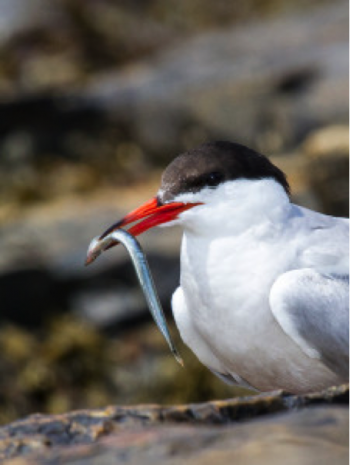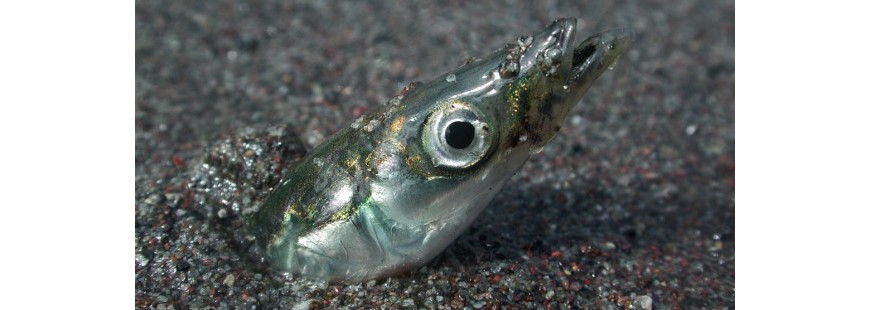Photo: Pacific Sand Lance
The National Marine Fisheries Service (NMFS) this month finalized a new rule put together by the Pacific Fishery Management Council (PFMC) that protects forage fish between California and Washington. On the West Coast, we’re celebrating.
Forage fish are the little marine critters that transfer energy up the food chain – from the most basic phytoplankton that convert sunlight into nutrients, all the way up to the most mega of marine fauna: sharks, whales, and the other behemoths of the sea. Species like herring, squid, smelt, and anchovies all play an important role as the quintessential middlemen of the sea.
Forage Fishery Applications
Don’t forget, though, that the mega-est of all the fauna benefiting from these protections are human beings. Most of the seafood Americans eat isn’t necessarily a protected forage species. But most of the seafood we eat dines primarily on those species. This new rule affords salmon, halibut, swordfish, and tuna a better chance of encountering their next lunch. Our dinner plates will be better for it.
The national trend in forage fish fisheries is toward reduction fisheries, that is, the processing of these fish not for food, but for use in fish oil nutritional supplements, fishmeal, fertilizer, and other industrial products. Species like lanternfishes, which constitute a huge portion of deep-sea biomass but have not usually been of use to fishermen using traditional methods, are now commercially attractive to large, international fishing concerns.
It is absolutely essential to the continued health of our marine ecosystems that we not allow those species to be exploited wholesale for products that are likely not going to be coming in on boats through our coastal ports nor ending up on the tables of American families.
Operation of the Rule

A Common Tern with a Sand Lance, via Wikipedia
The new rule gets a lot of things right. Its basic operation is to prohibit any new fishery on specifically identified forage fish species without an ecosystem-impact review by PFMC. It does so by amending the Fishery Management Plans for all target species under PFMC management.
The rule sends the message that the role of forage fish species is not to be taken lightly in the management of the fishery-supporting ecosystem. Our fish need food too, and we now have a mechanism in place to make sure that important sources of that food aren’t arbitrarily or blindly removed from the marine ecosystem. Maintaining a food source for target stocks addresses one of the myriad pressures on fishery productivity.
We applaud PFMC’s decision to name the species for which new fisheries have been prohibited. Given that “forage fish” isn’t defined under the Magnuson-Stevens Act, it would have been a mistake to issue a blanket rule prohibiting new fisheries on all forage species. Identifying the protected species gives the fishing community a measure of certainty in how the rule will be applied, and provided for a more robust discussion on potential impacts of the rule during the rulemaking process. The rule does not impact existing forage fish fisheries on the West Coast, such as herring and market squid.
We also support that new fisheries on these species aren’t outlawed into perpetuity. Fisheries management should take a “look before you leap” approach. The rule provides for new fisheries on these species within the confines of ecosystem sustainability. If all of a sudden there is massive demand for Pacific sandlance, for instance, PFMC can allow a fishery to develop at a measured pace and with an understanding of how it will impact the larger ecosystem. The effect will be the preservation of older fisheries that might depend on these new target species as a food source.
Going Forward
Forage fish are keystone species, forming the food base for many key fisheries, including salmon and albacore tuna. The economic life of our coastal communities is founded on fishing, and the health of forage fish populations ensures that there are fish to catch down the line. The commercial use of forage fish should be subject to the twin demands of both business and the health of the marine environment, just as fishermen themselves are. Preserving these fish preserves traditional fishing communities.
Like many new practices enshrined in law, this one carries the potential for a new regime of applications, potentially lengthy processes for consideration by licensing authorities, and expensive procedural barriers to entry. Much remains to be done in this arena, and we hope that PFMC and NMFS clarify the process, ecosystem requirements and timeline by which new forage fish fisheries could open. It’s our responsibility, along with other fisheries advocates, to work with NMFS in ensuring that this rule does what it’s supposed to do—protect vulnerable forage fish populations—while letting commercial fishermen keep making a living from the sea.
We hope this rule sparks a debate over the relative utility of reduction fisheries, given that the forage species they target are perfectly suitable to straight human consumption. Forage species could well be a value-added protein (and fish oil) source. Perhaps this rule starts the conversation about elevating the role of these species in the American diet.
Foraging Some Final Thoughts…
While we recognize that every impact of this new rule has yet to be told, fishermen on the West Coast are optimistic that this is the rare case where the federal government has gotten it absolutely right. It is an example of government action that both protects ongoing legitimate interests and will help defend those interests, especially for small commercial fishermen, from the inadvertently destructive efforts of those who would wring every dollar they can from the ocean, regardless of who hurts down the line.
We see our job at Pacific Coast Federation of Fishermen’s Associations to fulfill that mission as well, and when we listen to our fishermen, we hear an echo of those two imperatives. When waters are calm and stocks are plentiful, help us keep fishing. In times of trouble, protect what little we’ve got. We have high hopes this rule will help greatly in doing both.



Well said, time for grilled sardines on more menus!